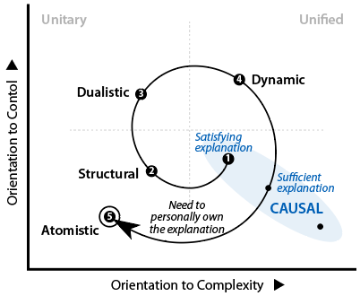Stage-5: Atomistic Ownership
![]() Reminder of the clarification process so far:
Reminder of the clarification process so far:
Personal Acceptance starts in the Atomistic Mode
An explanation may be superficially satisfying and apparently sufficient, and yet a person may do no more than acknowledge its value. Often most people view it as irrelevant, alien or too complicated to take seriously.
As long as that mentality persists, plans and activities to deal with the situation are likely to be half-hearted, misjudged or absent. If there is to be personal ownership, then the explanation must be assimilated and internalized: either independently and willingly or via social indoctrination. Clarity increases in that process.
Example
Making money in financial markets requires a strategy, and that means having a sufficient explanation of the evolving situation. The investor is typically exhorted to remain inactive till the right moment appears and not react to every fluctuation. Virtues like patience and control of fears are commonly advised, but this misses the point. If the investor actually owns the model-based narrative of the evolving market, then there will be minimal temptation to just react. That would feel wrong and be irresponsible.
:
To continue the subjective-objective and limited-comprehensive pattern (see previous summary): the is about enabling the operation of personal autonomy which is subjective; and because there is a simplification and adaptation to an existing mindset, the result will be limited.
Values & Assumptions

Promoting Acceptability
![]() Desired Benefit: Personal Ownership
Desired Benefit: Personal Ownership
Handling the Group
![]() Participation: Articulate a Position
Participation: Articulate a Position
![]() Communication: Foster Alternatives
Communication: Foster Alternatives
![]() Individualization: Assess the Evidence
Individualization: Assess the Evidence
Channeling Your Functioning:
My personal adoption of a framework, like that of purpose as presented in Stage-4, is essential if I am to offer it to people as a way to handle certain problems effectively. If it is not evident that I perceive their situation as understandable in terms of the framework, then it is almost impossible for them to adopt it and apply it for themselves.
But blind acceptance by the client is insufficient. Unless the client personally grasps and owns the framework in some basic way, then they cannot handle the challenges, issues and stresses in making necessary changes in the situation that presents. While it is to be expected that their grasp of the framework will be far more limited than mine, it must be solid. If not, at the first breakdown or seeming contradiction, they will default to the habitual or conventional thinking that got them into difficulties in the first place.
Limitations
Making a sufficient explanation your own gives you a position in your group and provides you with an outlook that can indicate whether change is called for. But often what is required is group acceptance.
Often it is necessary for most or at least a majority to own the explanation, and the question arises as to how more people can be persuaded to accept it.
There is also so the problem that each thoughtful person is likely to have a slightly different view. Something more is required to provide the basis for a group to adopt an explanation.
Settling at this Stage
If a person adopts the explanatory account and finds they can apply and use it effectively, then they will often reject looking any deeper and be unwilling to have their framework adjusted. In many cases, the secret to continuing success with their much-loved explanation is the avoidance of situations where the account does not apply or the avoidance of individuals who have come to a slightly different conclusion.
This recession into a shell would apply to psychoanalytic explanations and other doctrines or change-management tools. Academia provides an ideal way to avoid reality altogether and to pursue thinking unhindered by the need to persuade others or to handle the pressures and responsibilities associated with change.
On a mundane level, when a leading figure provides personal backing for an explanation, or an author or reporter clearly believes what they have written, many may be profoundly affected and inclined to go along rather than delve in personally for themselves. If this is the general or majority view, then there may be no felt need to seek further .
Transition
However, if there is disagreement, dissatisfaction or distrust, or if wider dissemination would be of great benefit, then it is necessary to bring some independent group-based and socio-culturally validated standards to bear on the explanation and personal accounts.
These standards might be found in:
- a dominant paradigm in scientific thinking
- culturally required rules of evidence
- philosophical demands for logic and evidence
- popular doctrines or paradigms
This fits the mode oscillation because such standards are offered as objective and they must be applied comprehensively.
The mode that naturally provides for the application of such standards appears to be the .
![]() Ruling Out the Alternative Move
Ruling Out the Alternative Move
- Move to Stage-6: Unitary Mode.
Originally posted: 30-Oct-2024.